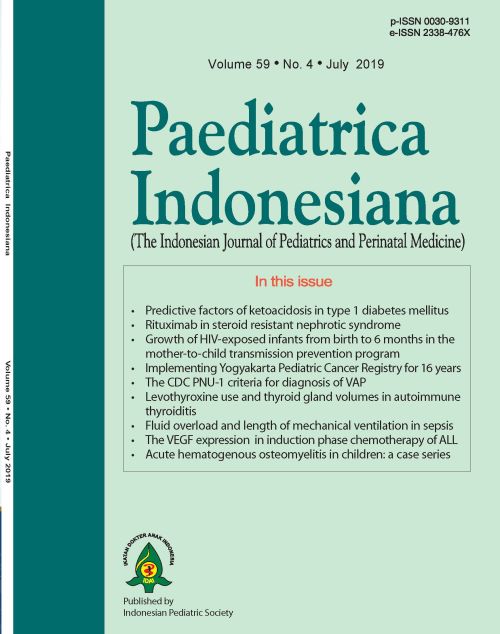Implementing Yogyakarta Pediatric Cancer Registry for 16 years
DOI:
https://doi.org/10.14238/pi59.4.2019.188-94Keywords:
childhood cancer registry, hospital-based cancer registry, childhood cancer incidenceAbstract
Background A hospital-based cancer registry can be used as a guide to decision-making. Considering the limited cancer registry data in the population, the Yogyakarta Pediatric Cancer Registry (YPCR) is one of the pioneers of hospital-based pediatric cancer registries in Indonesia. The YPCR was started in 2000 in Dr. Sardjito Hospital.
Objective To describe the characteristics of childhood cancer and the outcomes by analyzing overall survival (OS) and event-free survival (EFS) based on data from Yogyakarta Pediatric Cancer Registry.
Methods Data were collected from the YPCR for the period of 2000 to 2016. Childhood cancers were classified into 12 groups based on the 3rd edition International Classification for Childhood Cancer (ICCC). Incidence, frequency, and distribution of cases were grouped by sex, age, and patients’ place of residence. Incidence was further analyzed using SPSS software. Kaplan-Meier test was used to analyze OS and EFS.
Results Within the study period, 2,441 children aged 0-18 years were diagnosed with cancer. The highest incidence was found in the 1-5-year age group. The most common diagnoses found were leukemia, myeloproliferative disorders, and myelodysplastic disease (58%); lymphoma and reticuloendothelial neoplasm (8%); retinoblastoma (6%); soft tissue and other extra-osseous sarcomas (5%); as well as neuroblastoma and other peripheral nervous cell tumors (5%). The OSs of acute lymphoblastic leukemia (ALL), high risk ALL (HR-ALL), and standard risk (SR-ALL) were 31.8%, 18.5%, and 43.9%, respectively. The EFSs of ALL, HR-ALL, and SR-ALL were 23.9%, 14.7%, and 32.4%, respectively. For solid tumors, the OS was 13.7% and EFS was 6.4%.
Conclusion The number of new cases of childhood cancer has increased in the last few years. The Yogyakarta Pediatric Cancer Registry (YPCR), which serves as a hospital-based pediatric cancer registry, has an important role to evaluate clinical and non-clinical aspects of childhood cancer.
References
2. Michel G, von der Weid NX, Zwahlen M, Redmond S, Strippoli M-PF, Kuehni CE. Incidence of childhood cancer in Switzerland: The Swiss Childhood Cancer Registry. Pediatr Blood Cancer. 2008;50:46–51.
3. Katanoda K, Shibata A, Matsuda T, Hori M, Nakata K, Narita Y, et al. Childhood, adolescent and young adult cancer incidence in Japan in 2009-2011. Jpn J Clin Oncol. 2017;47(8):762–71.
4. Armstrong GT, Kawashima T, Leisenring W, Stratton K, Stovall M, Hudson MM, et al. Aging and risk of severe, disabling, life-threatening, and fatal events in the Childhood Cancer Survivor Study. J Clin Oncol. 2014;32:1218–27.
5. Rodriguez-Galindo C, Friedrich P, Morrissey L, Frazier L. Global challanges in pediatric oncology. Curr Opin Pediatr. 2013;25:3–15.
6. Valsecchi MG, Steliarova-Foucher E. Cancer registration in developing countries: luxury or necessity? Lancet Oncol. 2008;9:159–67.
7. Ali K, Sutaryo, Purwanto I, Mulatsih S, Supriyadi E, Widjajanto PH, et al. Yogyakarta Pediatric Cancer Registry: an international collaborative project of University Gadjah Mada, Univeristy of Saskatchewan, and the Saskatchewan Cancer Agency. Asian Pac J Cancer Prev. 2010;11:131–6.
8. Fritz A, Percy C, Jack A, Shanmugaratnam K, Sobin L, Parkin DM, et al., editors. International Classification of Disease for Oncology. 3rd ed. Geneva: World Health Organization; 2000.
9. Steliarova-Foucher E, Stiller C, Lacour B, Kaatsch P. International Classification of Childhood Cancer, third edition. Cancer. 2005;103:1457–67.
10. Johnson KJ, Carozza SE, Chow EJ, Fox EE, Horel S, McLaughlin CC, et al. Parental age and risk of childhood cancer: a pooled analysis. Epidemiology. 2009;20:475–83.
11. Martin RM, Gunnell D, Owen CG, Smith GD. Breast-feeding and childhood cancer: a systematic review with metaanalysis. Int J Cancer. 2005;117:1020–31.
12. Park HJ, Moon E-K, Yoon JY, Oh C-M, Jung K-W, Park BK, et al. Incidence and survival of childhood cancer in Korea. Cancer Res Treat. 2016;48:869–82.
13. Baade P, Youlden D, Valery P, Hassall T, Ward L, Green A, et al. Trends in incidence of childhood cancer in Australia, 1983-2006. Br J Cancer. 2010;102:620–6.
14. Mitra D, Shaw AK, Hutchings K. Trends in incidence of childhood cancer in Canada, 1992-2006. Chronic Dis Inj Can. 2012;32:131–9.
15. Howard SC, Metzger ML, Wilimas JA, Quintana Y, Pui C-H, Robison LL, et al. Childhood cancer epidemiology in low-income countries. Cancer. 2008;112:461–72.
16. Spector LG, Linabery AM. Childhood cancer incidence: is it really going up? Pediatr Blood Cancer. 2009;53:1–2.
17. Bao P-P, Zheng Y, Wang C-F, Gu K, Jin F, Lu W. Time trends and characteristics of childhood cancer among children age 0-14 in Shanghai. Pediatr Blood Cancer. 2009;53:13–6.
18. Linabery AM, Ross JA. Trends in Childhood Cancer Incidence in the U.S. (1992-2004). Cancer. 2008;112:416–32.
Downloads
Published
How to Cite
Issue
Section
License
Authors who publish with this journal agree to the following terms:
Authors retain copyright and grant the journal right of first publication with the work simultaneously licensed under a Creative Commons Attribution License that allows others to share the work with an acknowledgement of the work's authorship and initial publication in this journal.
Authors are able to enter into separate, additional contractual arrangements for the non-exclusive distribution of the journal's published version of the work (e.g., post it to an institutional repository or publish it in a book), with an acknowledgement of its initial publication in this journal.
Accepted 2019-07-17
Published 2019-07-17


















